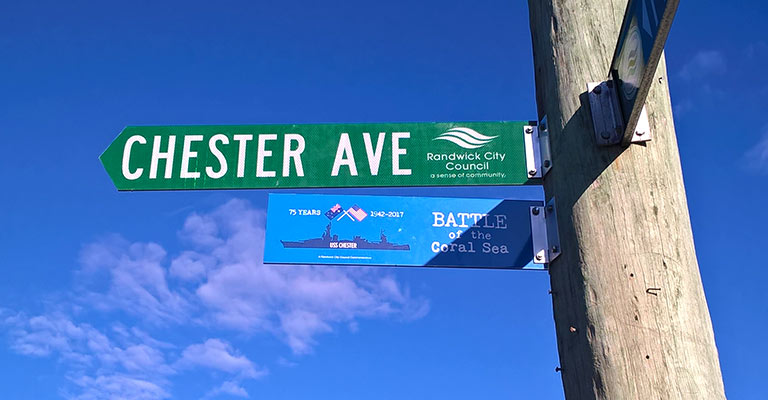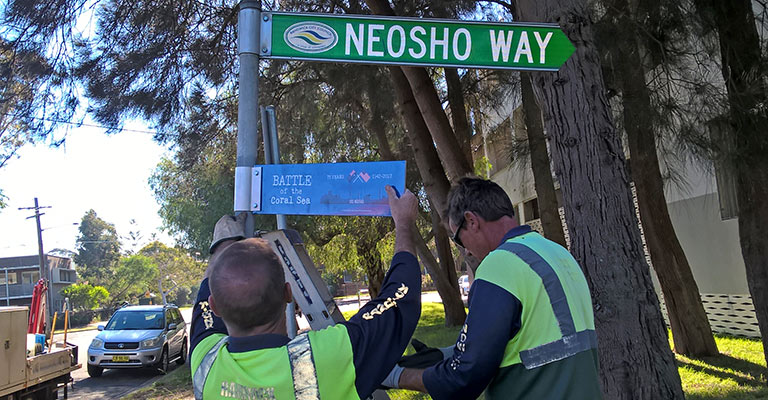Sand, snakes, speedway and ships: A fascinating look at Maroubra’s Coral Sea Park
- Published Date
- 04/05/2017
- News Topic
- Heritage, Art & Culture
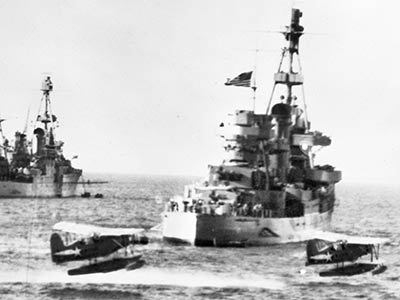
As the world marks the 75th anniversary of the Battle of the Coral Sea (4-8 May 1942), Randwick City Council Local Studies Librarian Georgina Keep looks back at the history of Maroubra's Coral Sea Park and the impact of this WWII conflict on the Randwick City community.
Coral Sea Park is situated on a sandy aquifer, part of the Botany Wetlands, extending throughout most of Eastern Sydney.
This fresh water source became one of Sydney’s earliest supplies of drinking water, but had no doubt helped sustain the local Indigenous population for many thousands of years before European settlement.
The land around Maroubra and Maroubra Beach was sparsely populated in the nineteenth century, an early watercolour by Miles Dumpy in 1910 shows the local landscape looking towards the beach.
The vista includes the Mortgage Agency C/L owned woolwash, established many years before this, by Humphrey McKeon. It was situated to take advantage of the swampy land, utilising the water in its manufacturing processes. It also shows the native vegetation, Xanthorrhoea still prevalent at this time, thriving in the sandy soil. It captures an idyllic location, somewhat isolated and remote from the congestion of inner city Sydney.
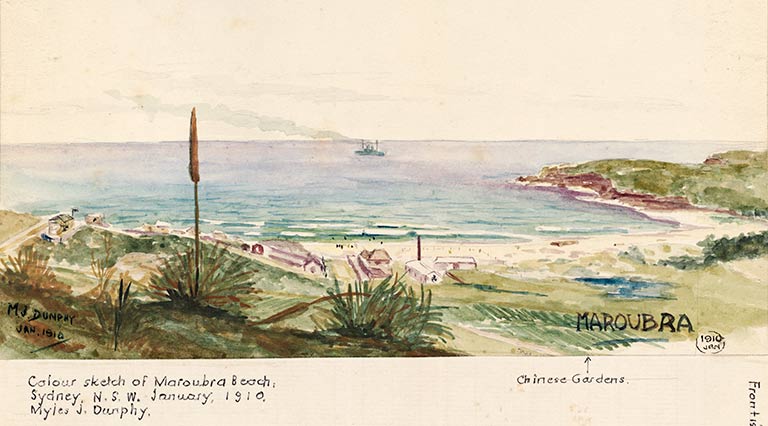
Maroubra the suburb began to take shape when Herbert Dudley, a local land owner and real estate developer, started offering land for sale in this picturesque location. To lure prospective residents away from the centre of Sydney, he built Dudley’s Emporium on the corner of Anzac Parade and Maroubra Bay Road. Taking full advantage of the commuter tram service along Anzac Parade, Dudley made a fortune. By the 1920s, Maroubra was booming.
One of the attractions of the suburb, by the mid-1920s, was the Maroubra Speedway. Enthusiasts from all over Sydney flocked to the corner of Anzac Parade and Fitzgerald Avenue Maroubra to witness the daring exploits of these motoring speed demons.
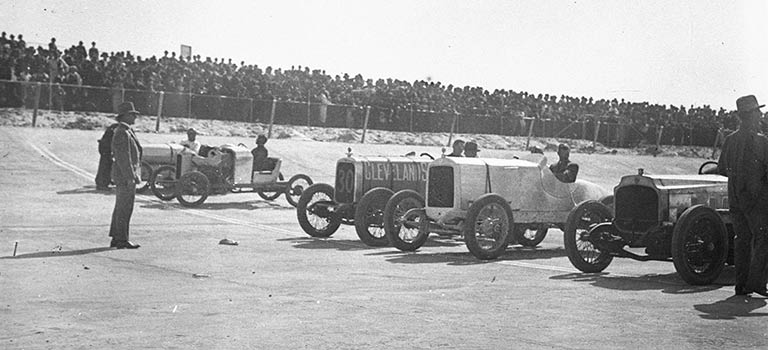
The following is an extract of the history of
the speedway taken from (Randwick: a Social History, pp199-203)
Forgotten by all but the older enthusiasts, the Maroubra Speedway deservedly holds a very special place in the history of Australia motor sport. Originally planned to be Australia’s answer to the world-famous Brooklands track in England, or the Indianapolis in America, the Olympic speedway at Maroubra drew the largest sporting crowds in New South wales and helped many famous motor car and motor cycle racing champions.
In 1923, a syndicate of Sydney businessmen financed the building of the speedway and appointed Arthur J Hunting, a member of the New South wales Motor Cycle Club, as manager. The track was to be situated on a lease of government land at the corner of Anzac parade and Fitzgerald Avenue.
Construction proved a mammoth feat, involving the pouring of thousands of tonnes of reinforced concrete, the building of access roads and perimeter fences, grandstands, garages, and a huge timber tower, and the draining of what turned out to be a snake infested marsh.
The completed track was surrounded on two sides by scrub and sandhills, which allowed would be spectators to gain a bird’s eye view of the races without paying a gate fee. Because of this, the sandhill gained the popular title of ‘Scotsman Hill’. Efforts to discourage the freeloaders by erecting fences of hessian bagging were constantly defeated by the wild weather of the area, so close to the Maroubra coastline.
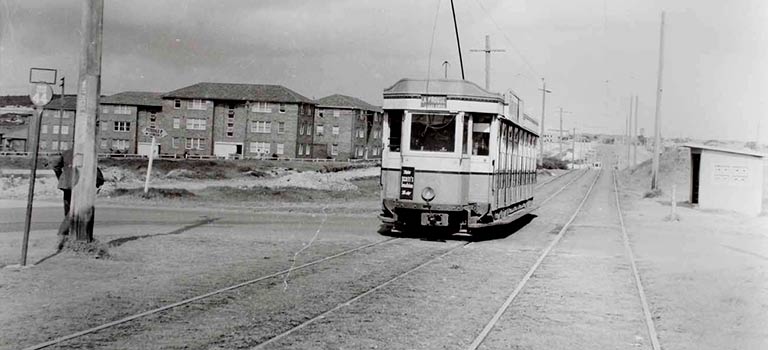
The official opening of the track was held on 5 December 1925, with promoters offering a purse of £1000. A crowd estimated by the Sydney Morning herald to be 67,000, swarmed into the complex. In years later, Hunting claimed the paying crowd exceeded 75 000, and if that figure was even reasonably accurate, it was bettered only by the 100,000 plus crowd that attended the 1925 Melbourne Cup…Maroubra and its dare-devil competitors became Sydney’s most talked about attraction.
Racing on the banked concrete track was more exciting than that on the dirt tracks with which it was competing, and with so much prize money offered, many competitors became full time professionals. Sadly, Maroubra Speedway claimed its first victims on 30 December 1925 when Leo Salmon and riding mechanic Harry Vaughn were both killed instantly while practising in their Jewwett special. It was the beginning of the spate of bad accidents and a number of fatalities, which eventually led to Maroubra being branded the “killer track”.
LP Davidson and his Harley Davidson motor cycle won the honour of being the first competitor – rider or driver- to lap Maroubra’s track in excess of 100 miles per hour. Much later, on 25 December 1925, Peter White, driving a fronty Ford, became the first driver to achieve the feet on four wheels.
Crowds at Maroubra began to dwindle after 1925. Motor cyclist Sid Sutton was killed in early 1926, and with newspapers inventing the ‘killer track’ name, attendance shrank to an unprofitable level of 4000 to 5000. In April 1926 the Speedway assets were purchased by Mr JS Taylor, a director of the failed company, for a mere £10,850. Taylor formed a new company with smallgoods baron Mr AW Anderson as a chairman of directors and announced the speedway would be floodlit for night racing. The huge concrete bowl bathed in brilliant electric light was re-opened in November 1926 before a crowd of 17000. Although crowds never returned to the 50-60000 of the first season, attendances grew to an average 18,000 to 20,000 every second Saturday night.
Then more tragedy. On 8 January 1927, track hero Reginald Gordon ‘Phil’ Garlick was killed instantly when his Alvis shot off the steeply banked northern bend, mowed down a lighting stanchion and crashed into the perimeter fence. On 29 January 1927, Maroubra claimed its fifth and last victim. Freddi Barlow left the bend at almost the same spot as salmon, Vaughn and Garlick, and he died the next day.
The impact of these deaths and the competition from motor racing at the Showground brought the closure of the Maroubra ‘bowl’ in the late 1929, when a group of motor cycle enthusiasts opened the course for cycle racing only. A rider of world renown and still a local resident Lionel Van Pragg, was active at Maroubra as an organiser and competitor in 1929 and 1930. He attributes his success at Maroubra to careful negotiation of the steeply banked northern bend, which had proved fatal to so many drivers in previous years. Despite a clean track record, the number of non-paying spectators using Scotman’s Hill and the onset of the depression forced the Speedway’s closure, and in 1934 the gates were locked and the giant speedway allowed to crumble. Gradually the majestic high banks cracked and collapsed and were demolished for filling material. The timing tower and garage complex simply collapsed and half sunk into the infield march, lending the desolate and decayed area the aspect on an ancient Roman ruin. The end for the once magnificent speedway came in 1947 when the property was resumed by the New South wales Housing Commission for use by a new generation of Maroubra residents.
Oral history legend has it that - in its derelict state – the speedway was a favourite haunt for snakes to “sun” themselves during the winter months, earning somewhat of a nickname as “the snake pit” before the redevelopment as a housing estate.
At the end of WWII, more housing was needed to accommodate a booming post-war population. Many of the young families taking up residence in this housing estate would have been returned servicemen, with their young and growing families.
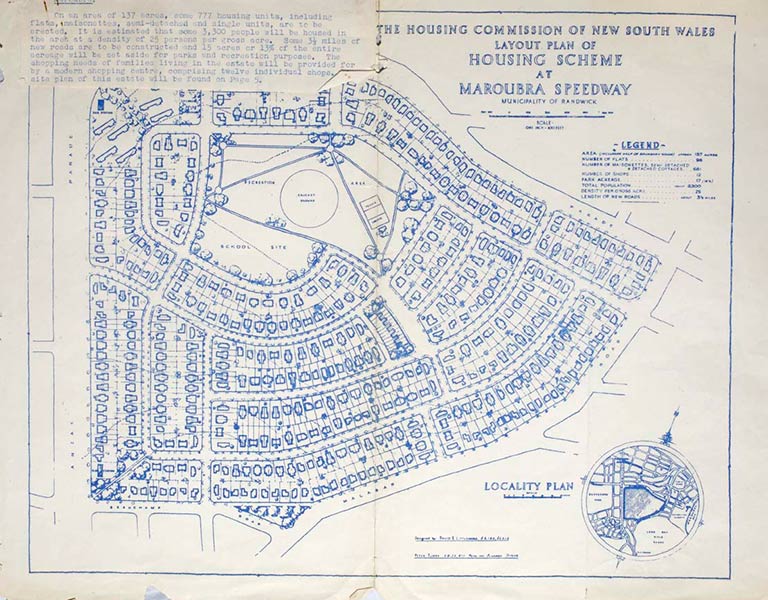
The blueprint for the design of the “Maroubra Speedway” government housing development, shows an ambitious plan with curved street designs and offset housing. At the conclusion of the war, Australian society was conscious of the sacrifice that so many made in the war effort. Across Australia, many landmarks, parks, streets and suburbs were renamed in honour of personalities and battles fought during the Second World War.
Coral Sea Park honours the Battle of the Coral Sea , a joint American-Australian air and sea battle that became a pivotal turning point in the Pacific campaign. The battle raged for several days 4–8 May 1942. It is considered the first time that the advancing Japanese military forces were halted . The Battle of the Coral Sea was the first action in which aircraft carriers engaged each other, as well as the first in which neither side's ships sighted or fired directly upon the other. It was followed closely by the Battle of Midway and the Battle of Guadalcanal, codenamed Operation Watchtower, also key battles in the war.
Although a tactical victory for the Japanese in terms of ships sunk, the battle would prove to be a strategic victory for the Allies for several reasons. The battle marked the first time since the start of the war that a major Japanese advance had been checked by the Allies. More importantly, the Japanese fleet carriers Shōkaku and Zuikaku – one damaged and the other with a depleted aircraft complement – were unable to participate in the Battle of Midway, which took place the following month, ensuring a rough parity in aircraft between the two adversaries and contributing significantly to the US victory in that battle. The severe losses in carriers at Midway prevented the Japanese from reattempting to invade Port Moresby from the ocean. Two months later, the Allies took advantage of Japan's resulting strategic vulnerability in the South Pacific and launched the Guadalcanal Campaign that, along with the New Guinea Campaign, eventually broke Japanese defences in the South Pacific and was a significant contributing factor to Japan's ultimate defeat in World War II. (Wikipedia article on the Battle of the Coral Sea)
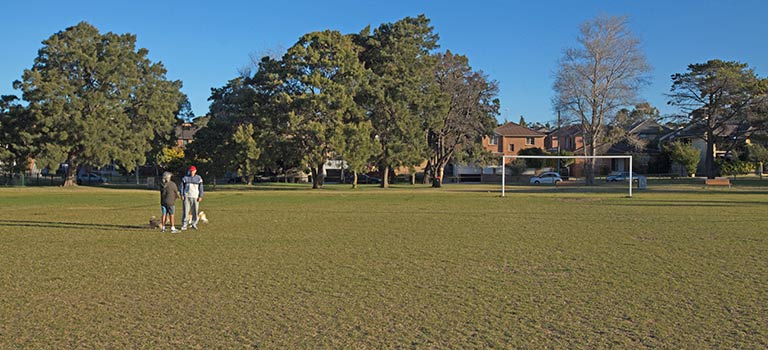
Many of the streets in the housing estate on the old Maroubra Speedway site are named after American ships that participated in the Battle of the Coral Sea. New Orleans Crescent, Yorktown Parade and Astoria Circuit to name a few. Coral Sea Park was officially dedicated at the special ceremony in involving visiting naval dignitaries, state government politicians and Randwick Council officials, 6 May 1960 . The war memorial unveiled at this ceremony has since been relocated with other memorials in the middle of Anzac Parade at Maroubra, close to the Maroubra RSL.
In 2017 Randwick Council marked the 75th anniversary of the Battle of the Coral Sea by installing special commemorative street signs in nearby streets named after US battle ships.
